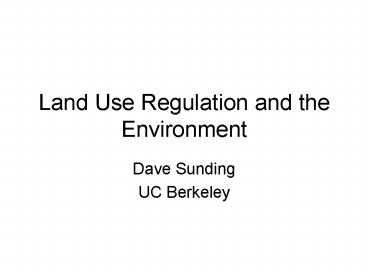Land Use Regulation and the Environment PowerPoint PPT Presentation
1 / 23
Title: Land Use Regulation and the Environment
1
Land Use Regulation and the Environment
- Dave Sunding
- UC Berkeley
2
Land Use Regulation and the Environment U.S.
Perspective
- Land use is regulated at local level.
- Environmental protection provided by both local
and central governments - Permitting
- Acquisition
- Begin with conceptual considerations
3
Public Goods
- Basic characteristics of public goods
- Nonrivalry in consumption (one persons
consumption does not impinge on anothers
consumption) - Nonexcludability (infeasible or too costly to
exclude some individuals from consumption)
4
Impure Public Goods
- Public goods can have a limited scope
- A city park may be a public good for people in
that city, but will anyone else want to use it? - Public goods can also be congestable
- Public goods with a physical location are often
congestable. - Supplying these goods efficiently requires a lot
of information about how they are used.
5
Spillovers
- Clean water and air are public goods that do not
correspond to political boundaries. - Pollution spills over from one jurisdiction to
the next. - Traffic is another example.
- Spillovers create an incentive for one government
to free-ride on abatement in other locations.
6
Providing Public Goods Conventional Wisdom
- Basic principle Jurisdiction of a government
should coincide with impacts of public goods it
supplies. - Public goods affecting neighborhoods should be
provided by cities. - Pure public goods should be provided by the
central government. - Congestable public goods should be provided by
local governments with superior information. - Spillovers should be handled by central
governments or by special districts.
7
Splicing and Factoring When Should Governments
Merge?
- Small number of governments with broad
jurisdiction--splicing. - Large number with narrow jurisdiction--factoring.
8
- Observations
- 1. Splicing increases likelihood of inconsistent
decisions. - Dissimilar people
- More dimensions
- 2. Splicing increases the scope for bargaining.
- Lowers TC
9
Government Competition
- Forms
- 1. People can move from one jurisdiction to
another. (Vote with your feet.) - 2. Agencies compete for authority.
- 3. Private sector can compete with government
agencies. - Is competition helpful or destructive?
10
Mobility
- Individual citizens have different preferences
for public goods, different income levels. - Efficiency requires clustering together people
with similar preferences. - Clustering implies policies closer to citizens
ideal points.
11
Mobility and Competition
- Make analogy to competitive markets - does
perfect competition among cities (perfect
mobility) lead to efficiency in the provision of
public goods? - Does many jurisdictions perfect competition?
- Tiebout explored this idea
12
Tiebout Hypothesis
- Location equilibrium is efficient.
- Equilibrium is such that nobody wishes they lived
somewhere else, given their characteristics. - Implication Mobility (free choice) leads to
efficient local government.
13
- Wide local latitude promotes diversity among
communities. Narrow local latitude promotes
diversity within communities. - What determines motives of local government?
Citizens buy into a community. Some economists
argue that goal of local government is to
maximize land values in the community.
14
Exclusion
- Sorting is not just influenced by taste--also by
income. - Because local public goods are still public
goods, citizens cannot be excluded. - Thus, a poor person who moves to a rich persons
neighborhood gets the rich persons level of
public goods. - Type of free riding
15
- Local governments rely on zoning rules to keep
poor people out. - Examples lot size, building height, types of
businesses. - Courts have intervened to prevent this.
16
Zoning for the Environment
- Suppose two firms laundry and power plant.
- If plant is close to laundry, this increases the
laundrys production costs. - Convex vs. Nonconvex Production Sets.
- Suppose power plant is far from laundry--then
production set is convex.
17
Laundry
L0
E0
Electricity
Convex
18
If power plant is too close to laundry,
production set is nonconvex.
Laundry
L0
E0
Electricity
Nonconvex
19
- There is an externality from power plant
operations. - Zoning can create value by controlling
externalities.
20
Laundry
10 miles
6 miles
3 miles
Electricity
21
- Zoning can be justified as a way to correct for
market failures--in this case, the failure of the
power plant owners to recognize their impact on
the laundry. - In reality, zoning boards respond to other
pressures as well. - Ability to grant a variance has high stakes,
especially to the landowner involved.
22
- There has been much empirical work on zoning.
- Most economists believe that zoning boards
attempt to maximize the value of property,
especially the property of the people who elected
them.
23
- Zoning and other regulation to protect local
public goods can be effective. - Public goods with wider scope probably require
central government intervention. - Examples from the U.S.
- Wetlands
- Endangered species

